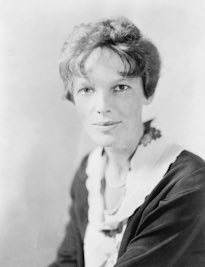Amelia Earhart was a vigorous adventurous child in her Kansas girlhood. Yet unlike generation-after-generation of American women, Earhart did not have to give up action and daring in adulthood. She worked as a volunteer in a Red Cross Hospital during First World War, studied briefly as a pre-med student, and taught English to immigrant factory workers. But her first love was the aeroplane, which was captivating the public’s imagination at the time. Surrounded by the excitement of stunt fliers and air shows, she made her first solo flight in 1921 and scraped together the money to buy her own plane.
In 1928, when Amelia Earhart was working in a settlement house in Boston, organizers of a transatlantic flight approached her. The woman they originally scheduled to be part of the team could not go, so they asked Earhart to take her place. “How could I refuse such a shining adventure!” she said. As the first woman to fly across the Atlantic, Earhart won the public’s affection, with the press dubbing her “Lady Lindy”—a female Charles Lindbergh – a widely recognized aeronautical figure, best known for making the first non-stop solo flight across the Atlantic Ocean in 1927.
Earhart became aviation editor of Cosmopolitan magazine, was active in Zonta International—a group committed to advancing the status of women and helped establish the Ninety-Nines—an organization of women pilots
After achieving a number of flight “firsts,” Amelia Earhart determined to do “just one more long flight.” In 1937, she took off from Miami heading east on an around-the-world course. Her Lockheed Electra was specially equipped, and Fred Noonan was her navigator. On July 2nd, they took off for the most difficult leg of the trip—from New Guinea to tiny Howland Island in the mid-Pacific. They never arrived, and an extensive air and sea search failed to turn up any trace of them.

